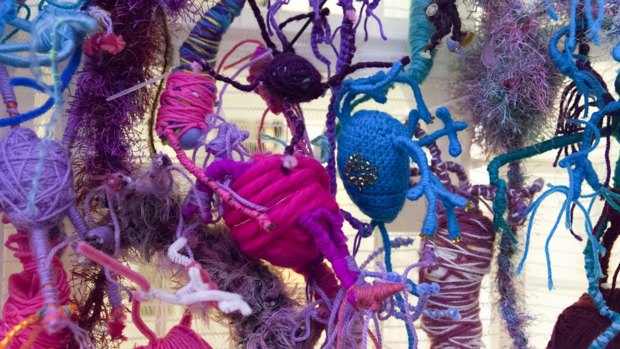By Andrew Masterson
Think of neuroscience and neither the craft of knitting nor, bless it, the gracious Murray River town of Echuca spring immediately to mind.
All three of these elements, however, will come together in glorious and educative harmony in mid-August. From August 15-23, Echuca's Campaspe Library will host a vast and colourful collection of knitted brain cells as its contribution to National Science Week.

Warm welcome: during Science Week, Echuca will host Neural Knitworks which explores brain functioning through knitted dendrites, axons and ganglia.
The woolly dendrites, axons and ganglia are the result of a community project called Neural Knitworks, coordinated by local business TwistED Science. The idea of Neural Knitworks emerged in Sydney in last year's National Science Week. A community yarn-fest resulted in 1665 colourful and complex 'neurons' that were then meshed together to create a giant walk-in brain inside a suburban gallery in suburban Hazelhurst.
The Echuca event is the brainchild (sorry) of TwistED's owner Kathy Stubberfield and her business development manager Laura Snow. In April this year the pair set up an activities room in a building opposite the library.
"We're not a museum so much as a play space," said Ms Snow. "We believe strongly in focusing on the imaginative and creative thought processes that happen in science."
Ms Snow said the knitting project was a happily novel way to generate interest in science among adults and children alike – an issue of direct relevance to the future of the town.
"We're in the middle of the nation's food bowl," said Ms Snow. "Food production is becoming increasingly reliant on science. There's a demand here for agronomists and engineers, for example. We hope to play a role in building capacity in the community – especially from a young age – so that it can provide the human resources to meet that demand."
In the matter of knitting brain cells, at least, the business appears to be hitting its target. After only a week, locals are visiting the building and running up at least five neurons every day. Others are doing the same thing at the library. Ms Snow said she was confident that by the time the National Science Week kicks off Echuca's collective brain will be large and colourful indeed.
As well as the riverine knit-fest, the annual science celebration this year features more than 1000 events across the country, spanning serious boffinry to child-friendly whimsy. Venues range from universities, museums and schools through to high streets and parks.
In this last category, for instance, adults and kids alike will be encouraged to gather at Ballarat's scenic Lake Wendouree on August 18, there to hunt for freshwater insects. The event will both aid the lake's custodians, the Corangamite Catchment Management Authority, to better understand its ecology and also, perhaps, awaken public interest in local wrigglies.
Underwater life of a different sort is the focus of a couple of events scheduled for the Rickett's Point marine sanctuary, at Beaumaris. The sessions, on August 15, include lectures on the ecology of Port Phillip Bay, and a leisurely beach walk.
The Science Week agenda attempts to cover a broad range of areas. This year, space exploration is particularly well represented. In part, this is because of a particularly hefty curtain-raiser event – a capital city speaking tour by world-famous US astrophysicist and author Dr Neil deGrasse Tyson. In Melbourne, Dr Tyson will appear at Jeff's Shed on August 7.
Star-gazing appetites thus whetted, Science Week offers many temptations for budding astronomers and cosmologists. The Melbourne Planetarium in Spotswood is hosting a number of events. Of special note is an evening on August 12 investigating the beguiling behaviour of dwarf planets, such as Ceres and Pluto, which stylishly combines listening to a lecture, peering through a telescope and sinking a glass of wine.
On the same subject, over at the Counihan Gallery in Brunswick, a group exhibition called Sky Lab "explores the speculative places of history and optics, the virtual worlds of imaging technologies, mapping space and alternative or fictional worlds." The show title is a reference to a US satellite that crashed near Kalgoorlie in 1979.
The smackdown highlight of Science Week's space program, however, is a gig at the Palais Theatre in St Kilda on August 20 by astronaut Colonel Chris Hadfield. Last year Colonel Hadfield became a bona fide YouTube sensation by making a number of very entertaining videos while based on the International Space Station. Among other things, he became the first bloke in history to sing David Bowie's Space Odditywhile actually floating in a tin can, high above the world …
Many schools across the state are staging events during the week. These include the Laburnum Primary School in Blackburn, where students will be marking the International Year of Light with an evening presentation, and the Mentone Girls' Grammar School, which will be hosting a breakfast featuring special guest Nicole Brown, a young engineer who heads a company called Robogals.
The Mentone gig implicitly recognises that women are under-represented in science and technology industries.
Another demographic that faces additional barriers to thinking about science as a career option are kids in rural and regional areas – for whom the delights of Scienceworks, the Melbourne Museum and open days at Monash are not easily accessed.
During Science Week, the primary school teachers in Warrnambool – 256 kilometres west of the city – will be doing a fine job of showing that science research can happen anywhere, and not just in sight of a tram-stop.
As their contribution to the International Year of Light, Year 5 and 6 students from three local primary schools are currently busy designing and building a range of solar-powered model boats. On Thursday, August 20, they will gather at Warrnambool West Primary to demonstrate their creations, powering them across four specially constructed test ponds in front of proud and highly impressed parents.
For a full rundown of Australian Science Week events, head to scienceweek.net.au